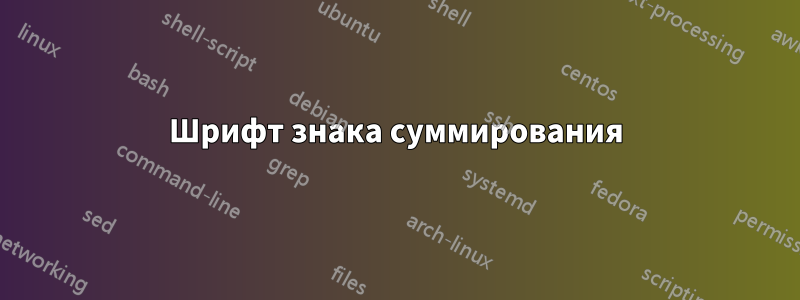
решение1
Обновление 1: 2024/05/03
Символ \sumвзят из пакета txfonts(или вы можете взять из Libertinus Math): см. краткий MWE и рисунок.
%% Compile and read me!
\documentclass[a4paper,12pt]{article}
\usepackage{txfonts}
\usepackage[T1]{fontenc}
\begin{document}
\[\sum^{n}_{i=1}{xcv}\]
\end{document}
С двигателем XeLaTeX: По моему скромному мнению, очень близкий \sumсимвол дается отSTIX Две математики. Я тоже пробовал Cambria Math(см. 2-й код), но он большой: но можно растянуть вертикально символ с помощью scalerelпакета (я не пробовал). Если вы знаете общий шрифт, вы отменяете STIX Two Mathи вводите название шрифта.
\documentclass[12pt]{article}
\usepackage{unicode-math}
\setmathfont{Latin Modern Math}
\setmathfont[range={\sum}, Scale=MatchUppercase]{STIX Two Math}
\let\mathbb\relax % remove the definition by unicode-math
\DeclareMathAlphabet{\mathbb}{U}{msb}{m}{n}
\begin{document}
The range of matrix $A\in\mathbb{K}^{I\times J}$ is
\[
\operatorname{range}(A)=\{Ax\colon x\in\mathbb{K}^{J}\}=\operatorname{span}\{A_{(j)},i\in J\}.
\]
Hence, the range of a matrix is a vector space spanned by its columns. The Euclidean scalar product in $\mathbb{K}^I$ is given by.
\[\langle x,y\rangle=y^Hx=\sum_{i\in I}x_i\bar{y}_i,\]
where for $\mathbb{K}=\mathbb{R}$ the conjugate sign can be ignored. It is often useful and very
\end{document}
или с помощью Cambria Math:
\documentclass[12pt]{article}
\usepackage{unicode-math}
\setmathfont{Latin Modern Math}
\setmathfont[range={\sum}, Scale=MatchUppercase]{Cambria Math}
\let\mathbb\relax % remove the definition by unicode-math
\DeclareMathAlphabet{\mathbb}{U}{msb}{m}{n}
\begin{document}
The range of matrix $A\in\mathbb{K}^{I\times J}$ is
\[
\operatorname{range}(A)=\{Ax\colon x\in\mathbb{K}^{J}\}=\operatorname{span}\{A_{(j)},i\in J\}.
\]
Hence, the range of a matrix is a vector space spanned by its columns. The Euclidean scalar product in $\mathbb{K}^I$ is given by.
\[\langle x,y\rangle=y^Hx=\sum_{i\in I}x_i\bar{y}_i,\]
where for $\mathbb{K}=\mathbb{R}$ the conjugate sign can be ignored. It is often useful and very
\end{document}
Вы также можете увидеть это TeX Gyre Pagella Math(хорошо):
\documentclass[12pt]{article}
\usepackage{unicode-math}
\setmathfont{Latin Modern Math}
\setmathfont[range={\sum}, Scale=MatchUppercase]{TeX Gyre Pagella Math}
\let\mathbb\relax % remove the definition by unicode-math
\DeclareMathAlphabet{\mathbb}{U}{msb}{m}{n}
\begin{document}
The range of matrix $A\in\mathbb{K}^{I\times J}$ is
\[
\operatorname{range}(A)=\{Ax\colon x\in\mathbb{K}^{J}\}=\operatorname{span}\{A_{(j)},i\in J\}.
\]
Hence, the range of a matrix is a vector space spanned by its colunns. The Euclidean scalar product in $\mathbb{K}^I$ is given by.
\[\langle x,y\rangle=y^Hx=\sum_{i\in I}x_i\bar{y}_i,\]
where for $\mathbb{K}=\mathbb{R}$ the conjugate sign can be ignored. It is often useful and very
\end{document}
с TeX Gyre Termes Math(хорошо):








